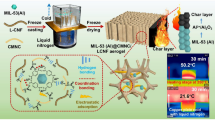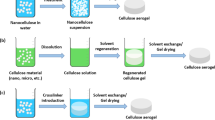Abstract
Organic and inorganic composite nanomaterials have been extensively investigated for diverse magnetic applications. However, the rigidity of the nanoparticles hinders their practical implementation. In this study, an environmentally benign composite flexible nanofiber membrane containing magnetic α-Fe2O3 nanoparticles and ethyl cellulose was fabricated by electrospinning. X-ray diffraction, FTIR, SEM and TEM investigated the structural properties systematically while VSM analysis was used to compare the magnetic properties of α-Fe2O3 and α-Fe2O3/C20H38O11 nanomaterials. XRD patterns exhibit all characteristics of the diffraction peaks of synthesized samples without any secondary phase. Sharp peaks were observed in FTIR spectral characteristic bands evince that absorption band becomes more prominent for α-Fe2O3/ethyl cellulose nanocomposite than pristine ethyl cellulose. SEM analysis reveals the homogenous growth of particles and uniformly, dense pattern of nanofiber membrane. TEM image demonstrates the complete dispersion of α-Fe2O3 nanoparticles within the ethyl cellulose matrix. The enhanced values of remnant and saturated magnetization of the α-Fe2O3/C20H38O11 nanofiber membrane exhibits the imperative role of nanocomposite in the flexible applications.
Graphic abstract
In this work, α-Fe2O3 nanoparticles were synthesized with the help of hydrothermal method and electrospinning was used to fabricate α-Fe2O3/C20H38O11 nanofiber membrane. The crystallite size calculated for α-Fe2O3 nanoparticle prepared by hydrothermal process is relatively larger than that for nanoparticles embedded within the α-Fe2O3/C20H38O11 nanofiber membrane. Significant decrease in the agglomeration of α-Fe2O3 nanoparticles within nanofiber membrane accounted for its enhanced the magnetic properties.








Similar content being viewed by others
Availability of data and materials
Not applicable.
Code availability
Not applicable.
References
Alavi AS, Meshkini A (2015) Fabrication of poly (ethylene glycol)-coated mesoporous nanocomposite ZnO@Fe2O3 for methotrexate delivery: an integrated nanoplatform for dual-mode cancer therapy. Eur J Pharm Sci 115:144–157. https://doi.org/10.1016/j.ejps.2018.01.027
Asgar H, Mohammed S, Kuzmenko I, Gadikota G (2019) Relating structural and microstructural evolution to the reactivity of cellulose and lignin during alkaline thermal treatment with Ca(OH)2 for sustainable energy production integrated with CO2 capture. ACS Sustain Chem Eng 7(5):5449–5461. https://doi.org/10.1021/acssuschemeng.8b06584
Barman A, Das M (2019) Cellulose-based hydrogels for pharmaceutical and biomedical applications. In: Mondal M (ed) Cellulose-based superabsorbent hydrogels. Springer, Cham, pp 1103–1130
Bian H, Gao Y, Luo J, Jiao L, Wu W, Fang G, Dai H (2019) Lignocellulosic nanofibrils produced using wheat straw and their pulping solid residue: from agricultural waste to cellulose nanomaterials. Waste Manag 1:1–8. https://doi.org/10.1016/j.wasman.2019.04.052
Boumaza S, Kabir H, Gharbi I, Belhadi A, Trari M (2018) Preparation and photocatalytic H2-production on α-Fe2O3 prepared by sol–gel. Int J Hydrogen Energy 43(6):3424–3430. https://doi.org/10.1016/j.ijhydene.2017.07.227
Deka S, Saxena V, Hasan A, Chandra P, Pandey LM (2018) Synthesis, characterization and in vitro analysis of α-Fe2O3–GdFeO3 biphasic materials as therapeutic agent for magnetic hyperthermia applications. Mater Sci Eng 92:932–941. https://doi.org/10.1016/j.msec.2018.07.042
Ghavimi MA, Sunar S, Shahabadi AB, Negahdari R (2019) Electrospun nanofibrous scaffolds for bone tissue engineering. J Adv Chem Pharm Mater (JACPM) 2(2):106–107
Hivechi A, Bahrami SH, Siegel RA (2019) Investigation of morphological, mechanical and biological properties of cellulose nanocrystal reinforced electrospun gelatin nanofibers. Int J Biol Macromol 124:411–417. https://doi.org/10.1016/j.ijbiomac.2018.11.214
Houshiar M, Zebhi F, Razi ZJ, Alidoust A, Askari Z (2014) Synthesis of cobalt ferrite (CoFe2O4) nanoparticles using combustion, coprecipitation, and precipitation methods: a comparison study of size, structural, and magnetic properties. J Magn Magn Mater 371:43–48. https://doi.org/10.1016/j.jmmm.2014.06.059
Huang LY, Yu DG, Branford-White C, Zhu LM (2012) Sustained release of ethyl cellulose micro-particulate drug delivery systems prepared using electrospraying. J Mater Sci. https://doi.org/10.1007/s10853-011-5913-x
Iervolino G, Vaiano V, Sannino D, Rizzo L, Galluzzi A, Polichetti M, Pepe G, Campiglia P (2018) Hydrogen production from glucose degradation in water and wastewater treated by Ru-LaFeO3/Fe2O3 magnetic particles photocatalysis and heterogeneous photo-Fenton. Int J Hydrogen Energy. https://doi.org/10.1016/j.ijhydene.2017.12.071
Kaur GA, Shandilya M, Rana P, Thakur S, Uniyal P (2020) Modification of structural and magnetic properties of Co0.5Ni0.5Fe2O4 nanoparticles embedded Polyvinylidene Fluoride nanofiber membrane via electrospinning method. Nano-Struct Nano-Objects 22:100428
Khalil HA, Davoudpour Y, Saurabh CK, Hossain MS, Adnan AS, Dungani R, Paridah MT, Sarker MZ, Fazita MN, Syakir MI, Haafiz MK (2016) A review on nanocellulosicfibres as new material for sustainable packaging: process and applications. Renew Sustain Energy Rev. https://doi.org/10.1016/j.rser.2016.06.072
Ko E, Park KS, Kim S, Kim T, Kim H (2019) Morphological study of cellulosic hydrogel nanofiber for biomedical application. Cellulose. https://doi.org/10.1007/s10570-019-02725-1
Kocić A, Bizjak M, Popović D, Poparić GB, Stanković SB (2019) UV protection afforded by textile fabrics made of natural and regenerated cellulose fibres. J Clean Prod. https://doi.org/10.1016/j.jclepro.2019.04.355
Konuklu Y, Erzin F, Akar HB, Turan AM (2019) Cellulose-based myristic acid composites for thermal energy storage applications. Sol Energy Mater Sol Cells. https://doi.org/10.1016/j.solmat.2019.01.006
Li S, Cui Z, Li D, Yue G, Liu J, Ding H, Gao S, Zhao Y, Wang N, Zhao Y (2019) Hierarchically structured electrospinning nanofibers for catalysis and energy storage. Compos Commun. https://doi.org/10.1016/j.coco.2019.01.008
Liu Y, Zhan Q, Wang B, Li H, Wu Y, Chen B, Sun D, Mao S, Li RW (2015) Modulation of magnetic anisotropy in flexible multiferroic FeGa/PVDF heterostructures under various strains. IEEE Trans Magn. https://doi.org/10.1109/TMAG.2015.2436413
Liu R, Wang P, Tao Y, Liu Y, Shen X (2016) Formation Mechanism of α-Fe2O3 nanotubes via electrospinning and their adsorption characteristics of BSA and DNA. J Nanosci Nanotechnol. https://doi.org/10.1166/jnn.2016.10717
Mohammad F, Arfin T, Al-Lohedan HA (2017) Sustained drug release and electrochemical performance of ethyl cellulose-magnesium hydrogen phosphate composite. Mater Sci Eng. https://doi.org/10.1016/j.msec.2016.10.062
Patterson AL (1939a) The Scherrer formula for X-ray particle size determination. Phys Rev. https://doi.org/10.1103/PhysRev.56.978
Patterson AL (1939b) The Scherrer formula for X-ray particle size determination. Phys Rev 56(10):978–982
Shandilya M, Kaur GA (2019) Low temperature crystal growth of lead-free complex perovskite nano-structure by using sol–gel hydrothermal process. J Solid State Chem 280:120988. https://doi.org/10.1016/j.jssc.2019.120988
Shandilya M, Rai R, Singh J (2016) Hydrothermal technology for smart materials. Adv Appl Ceram. https://doi.org/10.1080/17436753.2016.1157131
Venkateswarlu K, Bose AC, Rameshbabu N (2010) X-ray peak broadening studies of nanocrystalline hydroxyapatite by Williamson–Hall analysis. Physica B. https://doi.org/10.1016/j.physb.2010.07.020
Wang J, Chen X, Zhang C, Akbar AR, Shi Z, Yang Q, Xiong C (2019) Transparent konjac glucomannan/cellulose nanofibril composite films with improved mechanical properties and thermal stability. Cellulose. https://doi.org/10.1007/s10570-019-02302-6
Yu J, Zhu Y, Ma H, Liu L, Hu Y, Xu J, Wang Z, Fan Y (2019) Contribution of hemicellulose to cellulose nanofiber-based nanocomposite films with enhanced strength, flexibility and UV-blocking properties. Cellulose. https://doi.org/10.1007/s10570-019-02518-6
Zheng M, Tajvidi M, Tayeb AH, Stark NM (2019) Effects of bentonite on physical, mechanical and barrier properties of cellulose nanofibril hybrid films for packaging applications. Cellulose. https://doi.org/10.1007/s10570-019-02473-2
Acknowledgments
The authors wish to acknowledge financial support provided by the Department of Science and Technology (DST), Govt. of India, for financial support under the Research Project SR/WOS-A/LS-296/2017.
Funding
Authors are grateful to the Department of Science and Technology (DST), Govt. of India, for financial support under the Research Project SR/WOS-A/LS-296/2017.
Author information
Authors and Affiliations
Corresponding author
Ethics declarations
Conflict of interest
The authors confirm that there are no conflicts of interest.
Additional information
Publisher's Note
Springer Nature remains neutral with regard to jurisdictional claims in published maps and institutional affiliations.
Rights and permissions
About this article
Cite this article
Shandilya, M., Thakur, S. & Thakur, S. Magnetic amendment in the fabrication of environment friendly and biodegradable iron oxide/ethyl cellulose nanocomposite membrane via electrospinning. Cellulose 27, 10007–10017 (2020). https://doi.org/10.1007/s10570-020-03455-5
Received:
Accepted:
Published:
Issue Date:
DOI: https://doi.org/10.1007/s10570-020-03455-5




